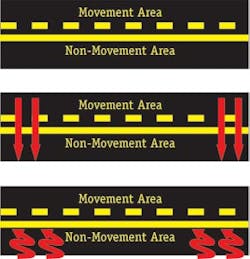Preventing runway incursions is one of the Federal Aviation Administration’s (FAA’s) highest priorities. Not only do they have the potential to put lives at risk due to the number and proximity of aircraft operating on the airport surface, but they take place in a complex and dynamic environment.
Every year there are accidents and incidents involving aircraft, pedestrians and ground vehicles at airports that lead to property damage and injury, which may be fatal. Many of these events result from inadequate security measures, a failure to maintain visuals aids, a lack of such aids and inadequate vehicle operator training.
Everyone’s cooperation is necessary to prevent serious accidents on airports. The FAA has an ongoing program aimed at pilots to help reduce runway incursions, pilot/controller miscommunications and airport surface mishaps. Everyone who operates vehicles or equipment on airports also has key responsibilities in these efforts.
Vehicle operators on airports face conditions that are not normally encountered during highway driving. Therefore, those persons who have vehicular access to the airside and a need to be there must have an appropriate level of knowledge of airport rules and regulations.
What Makes Up An Airport?
Besides the hangars (buildings for housing and servicing aircraft), airports are usually equipped with office and terminal buildings, which house administrative, traffic control, communication and weather observation personnel. An airport (airfield) is a place for landing and departure of aircraft and for receiving and discharging passengers and cargo. In addition to the wide paved strips known as runways, there are narrower paved strips called taxiways connecting the runways to other parts of the airport. A taxiway and a runway are usually connected at each end and at several intermediate points.
From a safety perspective, an airport is divided into two distinct areas. One area is known as the movement area, which is under the control of air traffic, and usually includes the runways, taxiways and other areas of an airport that aircraft use for taxiing, takeoff and landing. The other area, known as the non-movement area, usually includes taxi lanes, aprons, ramps and other areas not under the control of air traffic. The movement of aircraft or vehicles (i.e. tugs) within the non-movement area is the responsibility of the pilot, mechanics, the vehicle operator, or airport management.
Aprons or ramps are the areas where aircraft park, load and unload. Your work may require you to drive on an apron. If so, be very careful. Watch for aircraft that are moving and always yield the right-of-way to them. Don’t assume the pilot will see you and stop. He or she may be busy with other things.
In addition to watching for moving aircraft, be careful not to get too close to a parked aircraft. Aside from nicks and dents that are expensive to repair, you could be hurt if an aircraft suddenly started its engine and you were too close. You should also be aware of the problem of jet blast or prop wash. There have been several cases where vehicles have been overturned by jet blast. If a pilot is about to start the engine(s) or the engine(s) are running, the aircraft’s beacon should be flashing.
At most airports, the movement and non-movement areas are separated by a solid yellow line and a dashed yellow line (See Figure 1).
It is permissible to cross from the dashed side to the solid side (See Figure 1a); however, air traffic control (ATC) permission is always required to cross from the solid side to the dashed side at an airport with an operating control tower (See Figure 1b).
As an operator of a vehicle, you must get the controller’s permission before you go onto a runway or taxiway, their associated safety areas, or any other part of the movement area. There are at least two ways to get permission: By radio or advanced coordination with ATC. Check the airport diagram and be sure of the location of the movement areas.
What Should Vehicle Operators Know about Surface Incidents and Runway Incursions?
A surface incident is a broad term encompassing all movement areas (including runways and taxiways) and is “any event where unauthorized or unapproved movement occurs within the movement area, or an occurrence in the movement area associated with the operation of an aircraft that affects or could affect the safety of flight.”
Surface incidents may be caused by pilots and reported as pilot deviations (PD), by vehicle drivers or pedestrians and reported as vehicle/pedestrian deviations (V/PD), or by air traffic control and reported as operational errors/deviations (OE/OD). The FAA further classifies a surface incident as either a runway incursion or a non-runway incursion.
A runway incursion is “any occurrence on the airport runway environment involving an aircraft, vehicle, person, or object on the ground that creates a collision hazard or results in a loss of required separation with an aircraft taking off, intending to take off, landing, or intending to land.”
Where Can Vehicle Operators Be Found?
The vast majority of vehicle operators can be found performing their assigned tasks in the non-movement area of the airport. Ramps have markings for aircraft parking and tie downs. Some airport ramps also have special markings for vehicle operations. If there are vehicle or roadway markings, you should always drive your vehicle within those marked areas. In addition, taxi lanes may be marked on the apron to show aircraft routes to gates and parking areas.
Inadvertent entry by vehicles onto movement and non-movement areas of an airport poses a danger to both the vehicle operator and aircraft that are attempting to land or take-off or that are maneuvering on the airport. Methods for controlling access to the airside will vary depending on the type and location of the airport.
Since January 2000, vehicle operators have been involved in approximately 1,958 surface incidents/runway incursions (See Figure 2). After analyzing the preliminary incident reports, it was found that the vehicle operators did not have any problem with communications or communicating with air traffic.
As a matter of fact, air traffic reported vehicle operators had acknowledged and read the instructions back correctly; however, they still proceeded into the movement area, crossed active runways and entered active taxiways without proper authorization or clearance. When the completed investigation reports were analyzed, it became apparent that quite a few of the vehicle operators may have been unfamiliar with the markings and signs that were associated with ATC instructions.
Example: ATC gave instructions for the vehicle operator to hold short of a particular runway. Figure 3 shows what ATC would expect the vehicle operator to do; however, Figure 4 shows what the vehicle operator actually did. This is one example of a surface incident that could ultimately lead to a runway incursion.
The recognition and understanding of markings, especially those associated with ATC instructions, is of paramount importance to preventing incursions. Through communications the FAA hopes to determine if it was a failure on the part of the vehicle operators to recognize the airport markings that lead to the incursions or if they were preoccupied performing other tasks.
Airport operators should keep vehicular and pedestrian activity on the airside of the airport to a minimum. Vehicles on the airside of the airport should be limited to those vehicles necessary to support the operation of aircraft services, cargo and passenger services, emergency and maintenance of the airport. Vehicles should use service roads or public roads in lieu of crossing movement areas whenever possible. Where vehicular traffic on airport operation areas cannot be avoided, it should be carefully controlled.
Navigating Around the Airport
Most towered airports have markings, signs and lights designed to assist you in navigating around the airfield. Runways are identified by the wide, white-painted edge lines and white-painted dashed center line. Taxiways are marked with double yellow-painted edge lines and a yellow-painted solid center line. Remember, the yellow taxiway center lines may lead on, lead off, or cross a runway.
During low visibility or night operations, the runways, in addition to the white-painted markings, have white lights along the edge, center line and touchdown zone. However, it should be noted that on instrument runways the last 2,000 feet have yellow edge lights. Taxiways are illuminated with blue edge lights (or reflectors) and green center line lights (or reflectors). Vehicle operators need to know that when these markings, signs and lights are missed or ignored, the opportunity for errors increases. Guidance on how to operate safely in the airport environment is critical.
What Can Be Done?
The Office of Runway Safety & Operational Services offers the following recommendations:
(1) Airport operators should establish training procedures and policies concerning vehicle access and vehicle operation on the airside of the airport. These training procedures and policies should address such matters as access, vehicle operator requirements, vehicle requirements, operations and enforcement and should be incorporated into tenant leases and agreements.
(2) Vehicles that routinely operate on the airside should be marked or flagged for high daytime visibility and, if appropriate, lighted for nighttime operations. Vehicles that are equipped with marking and lighting devices should escort vehicles that are not marked and lighted.
(3) Companies operating on the airport should invest some time in conducting training on airfield
markings, signs and lights or ensure that their vehicle operators attend equivalent training that may be conducted by airport operations. This training should be specific to the airport where they operate.





